Aldi's Marketing Mix: A Detailed Strategic Analysis Report
VerifiedAdded on 2020/04/01
|11
|2123
|107
Report
AI Summary
This report provides a comprehensive analysis of Aldi's marketing strategies, examining how the company utilizes place, price, product, and promotion to gain a competitive advantage in the retail market. It begins with a background analysis, detailing Aldi's history, globalization, and entry into the Australian market, highlighting its rise as a top retailer. The report delves into Aldi's marketing mix, emphasizing its low-price strategy and high-quality product offerings. It also explores strategic marketing options like digital marketing, guerilla marketing, and relationship marketing that Aldi could adopt to further enhance its market position. The report concludes with a summary of key findings and recommendations, offering insights into Aldi's continued success and future growth strategies.
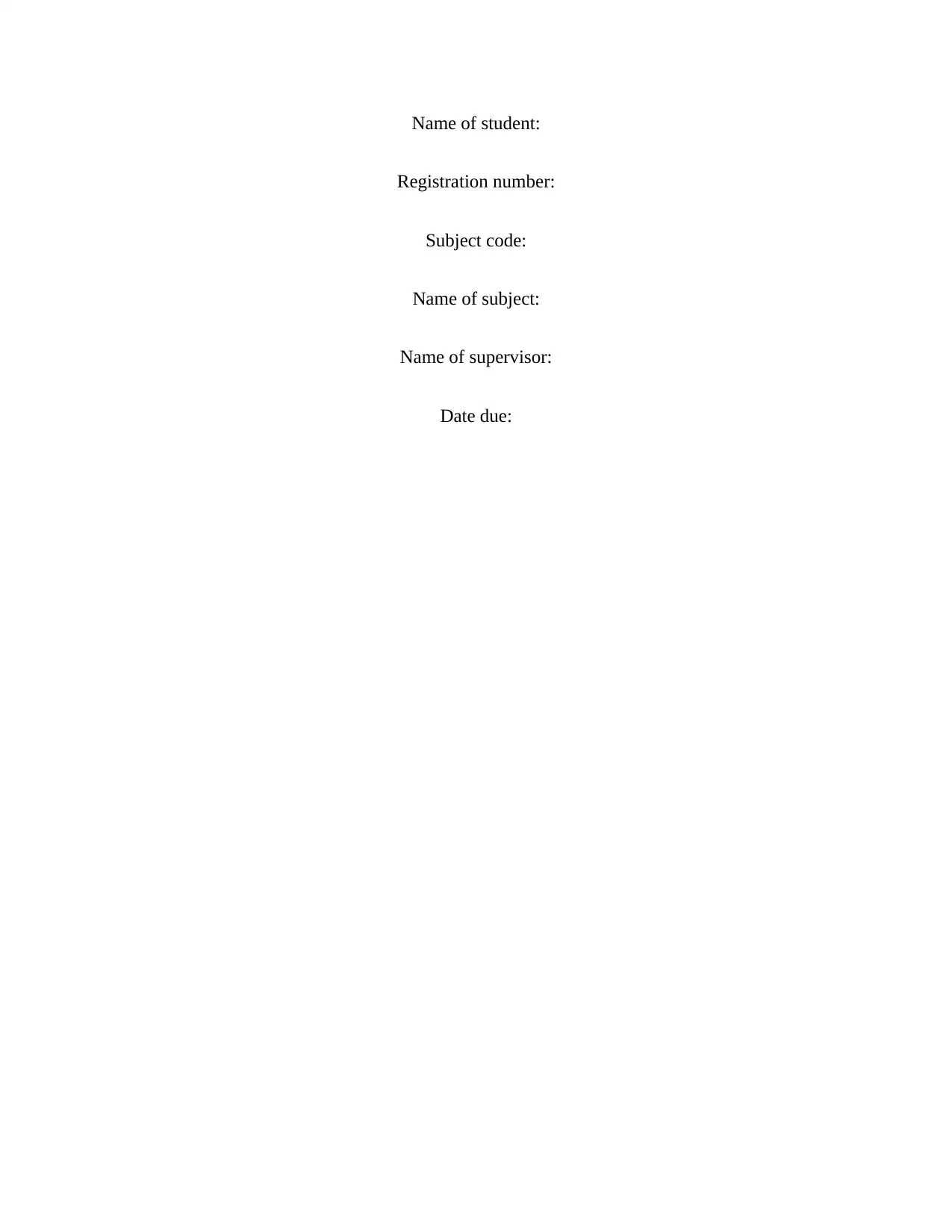
Name of student:
Registration number:
Subject code:
Name of subject:
Name of supervisor:
Date due:
Registration number:
Subject code:
Name of subject:
Name of supervisor:
Date due:
Paraphrase This Document
Need a fresh take? Get an instant paraphrase of this document with our AI Paraphraser
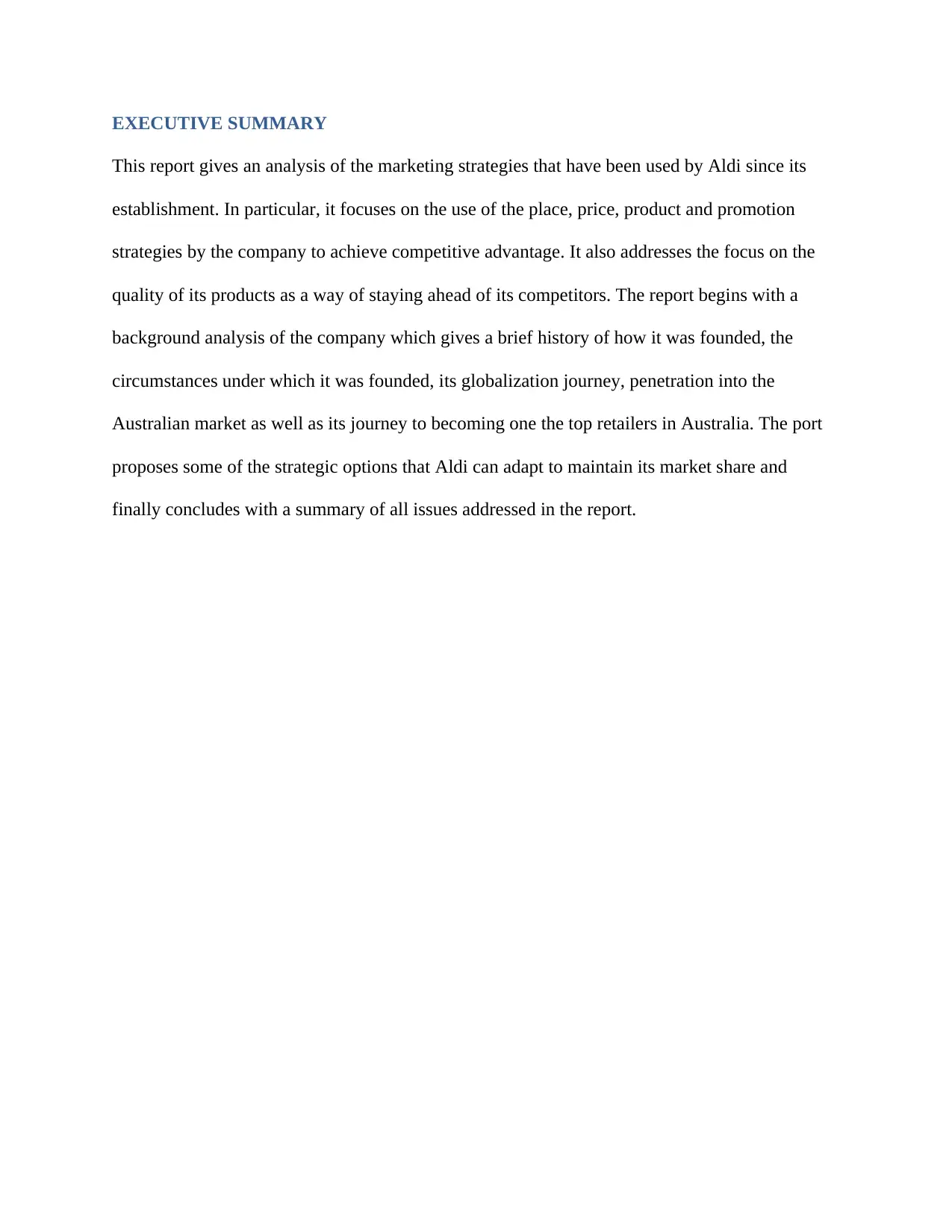
EXECUTIVE SUMMARY
This report gives an analysis of the marketing strategies that have been used by Aldi since its
establishment. In particular, it focuses on the use of the place, price, product and promotion
strategies by the company to achieve competitive advantage. It also addresses the focus on the
quality of its products as a way of staying ahead of its competitors. The report begins with a
background analysis of the company which gives a brief history of how it was founded, the
circumstances under which it was founded, its globalization journey, penetration into the
Australian market as well as its journey to becoming one the top retailers in Australia. The port
proposes some of the strategic options that Aldi can adapt to maintain its market share and
finally concludes with a summary of all issues addressed in the report.
This report gives an analysis of the marketing strategies that have been used by Aldi since its
establishment. In particular, it focuses on the use of the place, price, product and promotion
strategies by the company to achieve competitive advantage. It also addresses the focus on the
quality of its products as a way of staying ahead of its competitors. The report begins with a
background analysis of the company which gives a brief history of how it was founded, the
circumstances under which it was founded, its globalization journey, penetration into the
Australian market as well as its journey to becoming one the top retailers in Australia. The port
proposes some of the strategic options that Aldi can adapt to maintain its market share and
finally concludes with a summary of all issues addressed in the report.
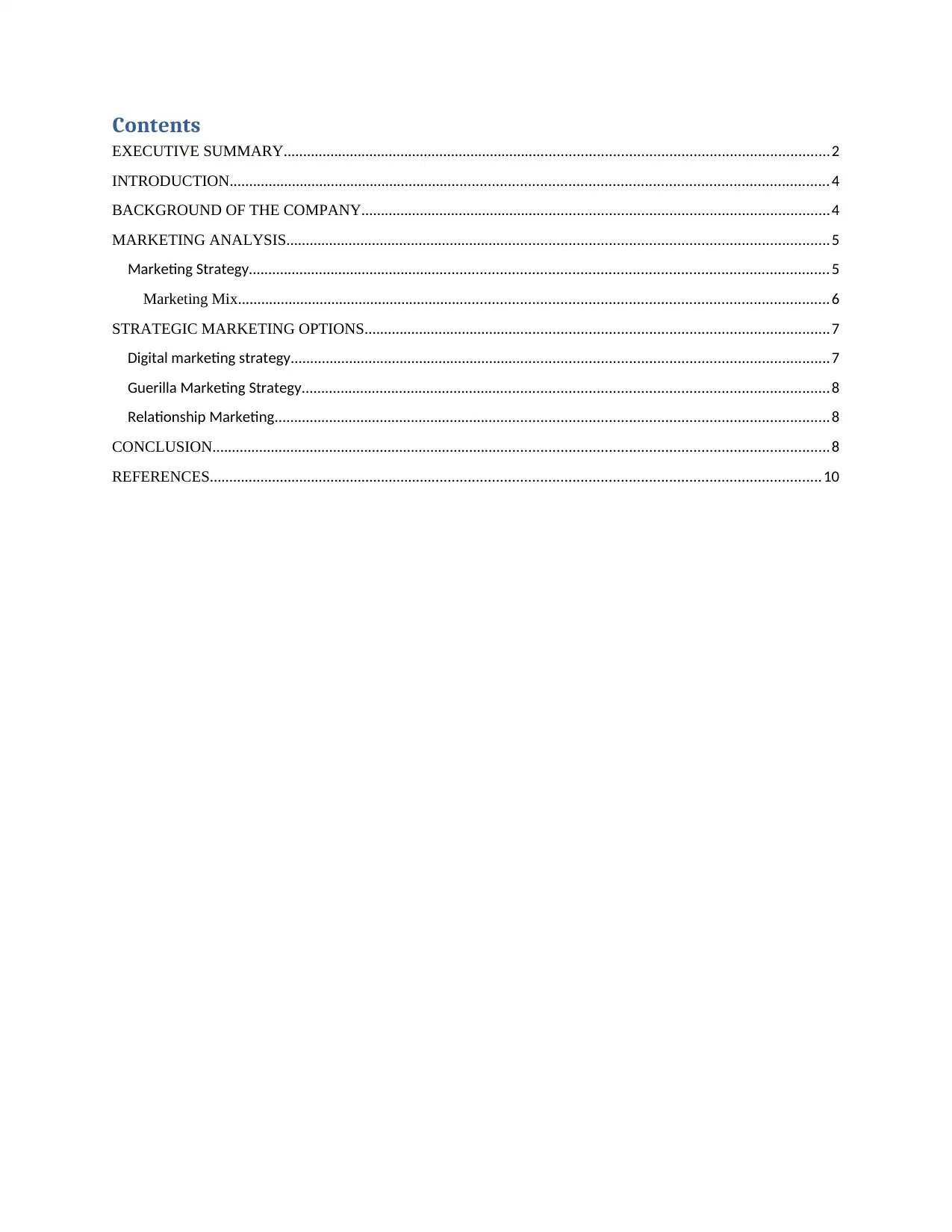
Contents
EXECUTIVE SUMMARY..........................................................................................................................................2
INTRODUCTION....................................................................................................................................................... 4
BACKGROUND OF THE COMPANY......................................................................................................................4
MARKETING ANALYSIS.........................................................................................................................................5
Marketing Strategy.................................................................................................................................................. 5
Marketing Mix.....................................................................................................................................................6
STRATEGIC MARKETING OPTIONS.....................................................................................................................7
Digital marketing strategy........................................................................................................................................7
Guerilla Marketing Strategy.....................................................................................................................................8
Relationship Marketing............................................................................................................................................8
CONCLUSION............................................................................................................................................................8
REFERENCES.......................................................................................................................................................... 10
EXECUTIVE SUMMARY..........................................................................................................................................2
INTRODUCTION....................................................................................................................................................... 4
BACKGROUND OF THE COMPANY......................................................................................................................4
MARKETING ANALYSIS.........................................................................................................................................5
Marketing Strategy.................................................................................................................................................. 5
Marketing Mix.....................................................................................................................................................6
STRATEGIC MARKETING OPTIONS.....................................................................................................................7
Digital marketing strategy........................................................................................................................................7
Guerilla Marketing Strategy.....................................................................................................................................8
Relationship Marketing............................................................................................................................................8
CONCLUSION............................................................................................................................................................8
REFERENCES.......................................................................................................................................................... 10
⊘ This is a preview!⊘
Do you want full access?
Subscribe today to unlock all pages.

Trusted by 1+ million students worldwide
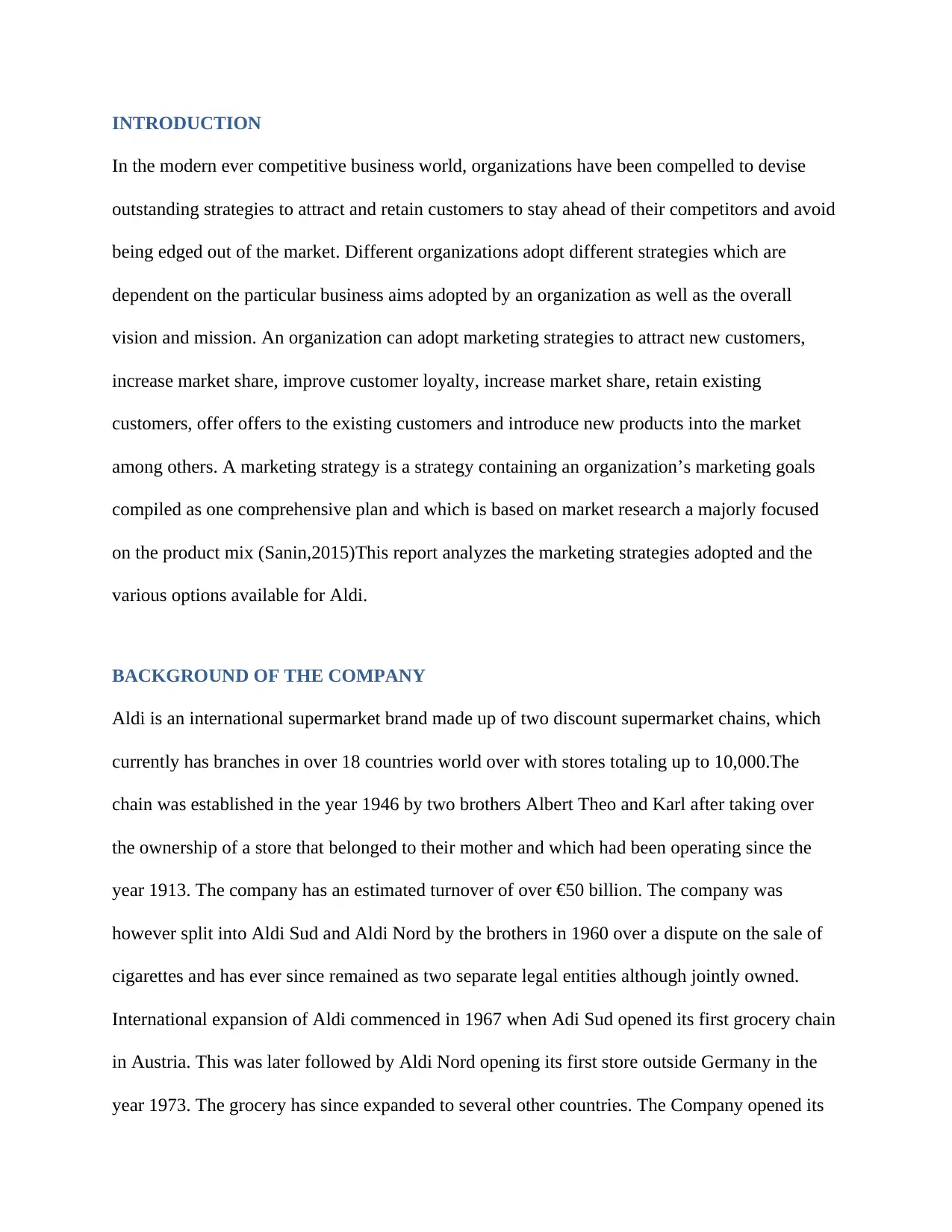
INTRODUCTION
In the modern ever competitive business world, organizations have been compelled to devise
outstanding strategies to attract and retain customers to stay ahead of their competitors and avoid
being edged out of the market. Different organizations adopt different strategies which are
dependent on the particular business aims adopted by an organization as well as the overall
vision and mission. An organization can adopt marketing strategies to attract new customers,
increase market share, improve customer loyalty, increase market share, retain existing
customers, offer offers to the existing customers and introduce new products into the market
among others. A marketing strategy is a strategy containing an organization’s marketing goals
compiled as one comprehensive plan and which is based on market research a majorly focused
on the product mix (Sanin,2015)This report analyzes the marketing strategies adopted and the
various options available for Aldi.
BACKGROUND OF THE COMPANY
Aldi is an international supermarket brand made up of two discount supermarket chains, which
currently has branches in over 18 countries world over with stores totaling up to 10,000.The
chain was established in the year 1946 by two brothers Albert Theo and Karl after taking over
the ownership of a store that belonged to their mother and which had been operating since the
year 1913. The company has an estimated turnover of over €50 billion. The company was
however split into Aldi Sud and Aldi Nord by the brothers in 1960 over a dispute on the sale of
cigarettes and has ever since remained as two separate legal entities although jointly owned.
International expansion of Aldi commenced in 1967 when Adi Sud opened its first grocery chain
in Austria. This was later followed by Aldi Nord opening its first store outside Germany in the
year 1973. The grocery has since expanded to several other countries. The Company opened its
In the modern ever competitive business world, organizations have been compelled to devise
outstanding strategies to attract and retain customers to stay ahead of their competitors and avoid
being edged out of the market. Different organizations adopt different strategies which are
dependent on the particular business aims adopted by an organization as well as the overall
vision and mission. An organization can adopt marketing strategies to attract new customers,
increase market share, improve customer loyalty, increase market share, retain existing
customers, offer offers to the existing customers and introduce new products into the market
among others. A marketing strategy is a strategy containing an organization’s marketing goals
compiled as one comprehensive plan and which is based on market research a majorly focused
on the product mix (Sanin,2015)This report analyzes the marketing strategies adopted and the
various options available for Aldi.
BACKGROUND OF THE COMPANY
Aldi is an international supermarket brand made up of two discount supermarket chains, which
currently has branches in over 18 countries world over with stores totaling up to 10,000.The
chain was established in the year 1946 by two brothers Albert Theo and Karl after taking over
the ownership of a store that belonged to their mother and which had been operating since the
year 1913. The company has an estimated turnover of over €50 billion. The company was
however split into Aldi Sud and Aldi Nord by the brothers in 1960 over a dispute on the sale of
cigarettes and has ever since remained as two separate legal entities although jointly owned.
International expansion of Aldi commenced in 1967 when Adi Sud opened its first grocery chain
in Austria. This was later followed by Aldi Nord opening its first store outside Germany in the
year 1973. The grocery has since expanded to several other countries. The Company opened its
Paraphrase This Document
Need a fresh take? Get an instant paraphrase of this document with our AI Paraphraser
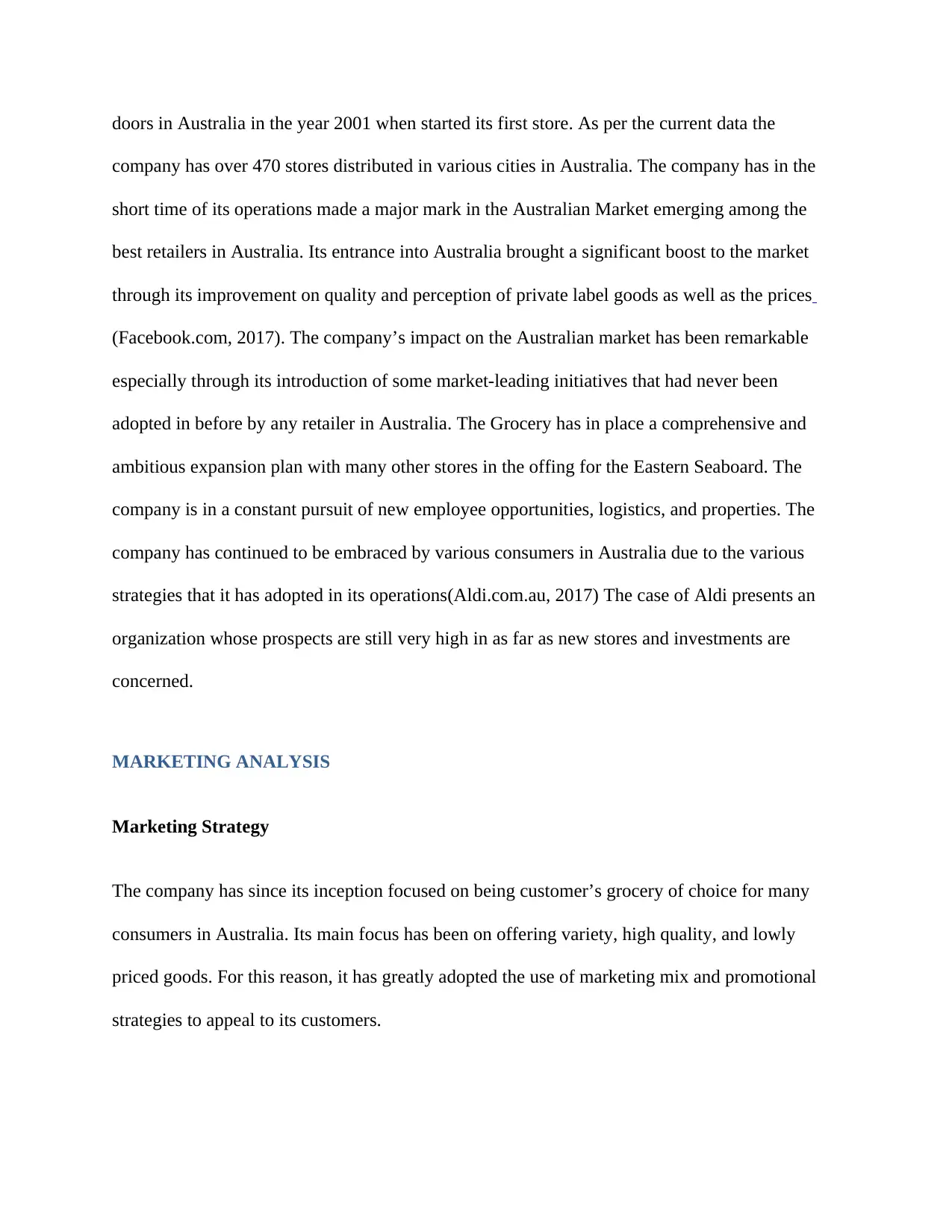
doors in Australia in the year 2001 when started its first store. As per the current data the
company has over 470 stores distributed in various cities in Australia. The company has in the
short time of its operations made a major mark in the Australian Market emerging among the
best retailers in Australia. Its entrance into Australia brought a significant boost to the market
through its improvement on quality and perception of private label goods as well as the prices
(Facebook.com, 2017). The company’s impact on the Australian market has been remarkable
especially through its introduction of some market-leading initiatives that had never been
adopted in before by any retailer in Australia. The Grocery has in place a comprehensive and
ambitious expansion plan with many other stores in the offing for the Eastern Seaboard. The
company is in a constant pursuit of new employee opportunities, logistics, and properties. The
company has continued to be embraced by various consumers in Australia due to the various
strategies that it has adopted in its operations(Aldi.com.au, 2017) The case of Aldi presents an
organization whose prospects are still very high in as far as new stores and investments are
concerned.
MARKETING ANALYSIS
Marketing Strategy
The company has since its inception focused on being customer’s grocery of choice for many
consumers in Australia. Its main focus has been on offering variety, high quality, and lowly
priced goods. For this reason, it has greatly adopted the use of marketing mix and promotional
strategies to appeal to its customers.
company has over 470 stores distributed in various cities in Australia. The company has in the
short time of its operations made a major mark in the Australian Market emerging among the
best retailers in Australia. Its entrance into Australia brought a significant boost to the market
through its improvement on quality and perception of private label goods as well as the prices
(Facebook.com, 2017). The company’s impact on the Australian market has been remarkable
especially through its introduction of some market-leading initiatives that had never been
adopted in before by any retailer in Australia. The Grocery has in place a comprehensive and
ambitious expansion plan with many other stores in the offing for the Eastern Seaboard. The
company is in a constant pursuit of new employee opportunities, logistics, and properties. The
company has continued to be embraced by various consumers in Australia due to the various
strategies that it has adopted in its operations(Aldi.com.au, 2017) The case of Aldi presents an
organization whose prospects are still very high in as far as new stores and investments are
concerned.
MARKETING ANALYSIS
Marketing Strategy
The company has since its inception focused on being customer’s grocery of choice for many
consumers in Australia. Its main focus has been on offering variety, high quality, and lowly
priced goods. For this reason, it has greatly adopted the use of marketing mix and promotional
strategies to appeal to its customers.
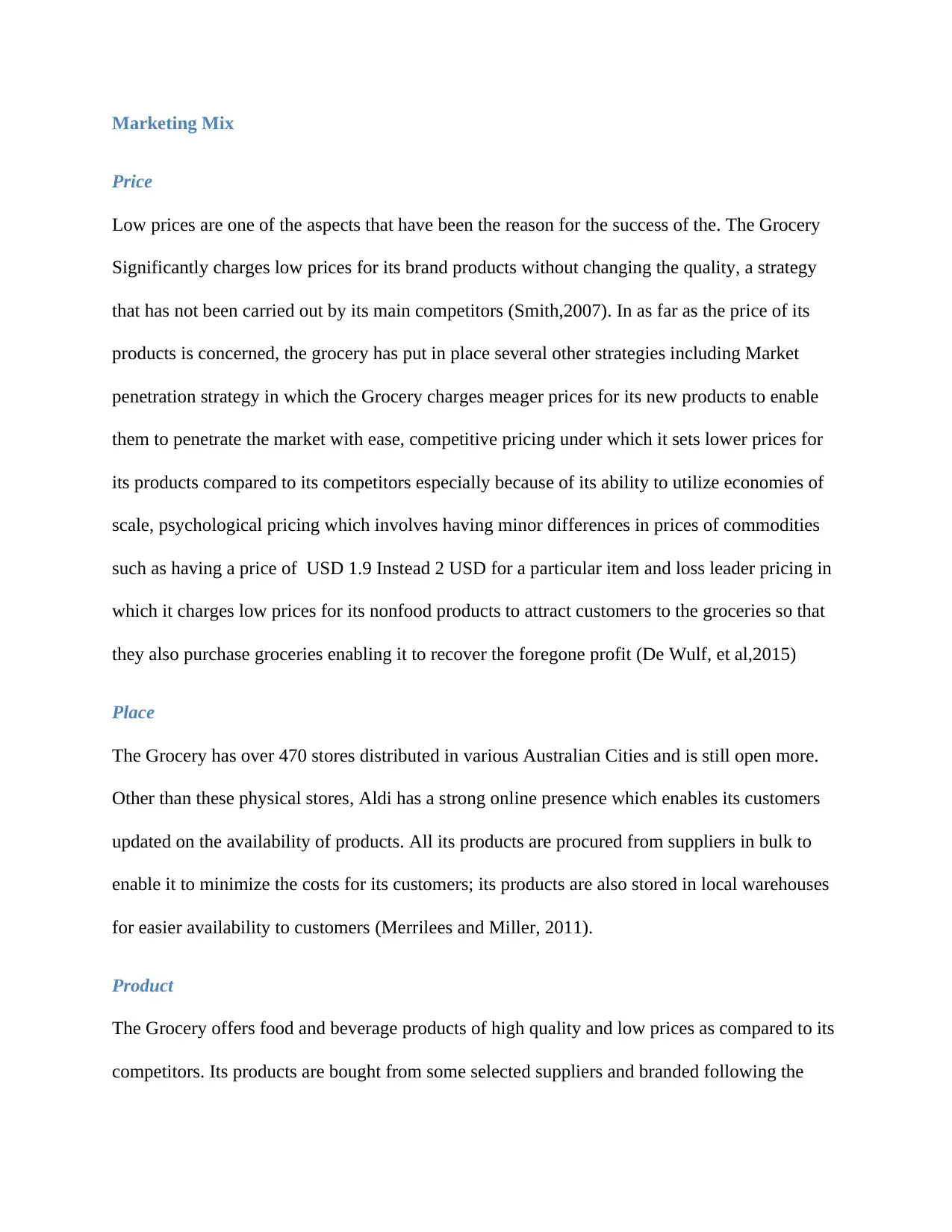
Marketing Mix
Price
Low prices are one of the aspects that have been the reason for the success of the. The Grocery
Significantly charges low prices for its brand products without changing the quality, a strategy
that has not been carried out by its main competitors (Smith,2007). In as far as the price of its
products is concerned, the grocery has put in place several other strategies including Market
penetration strategy in which the Grocery charges meager prices for its new products to enable
them to penetrate the market with ease, competitive pricing under which it sets lower prices for
its products compared to its competitors especially because of its ability to utilize economies of
scale, psychological pricing which involves having minor differences in prices of commodities
such as having a price of USD 1.9 Instead 2 USD for a particular item and loss leader pricing in
which it charges low prices for its nonfood products to attract customers to the groceries so that
they also purchase groceries enabling it to recover the foregone profit (De Wulf, et al,2015)
Place
The Grocery has over 470 stores distributed in various Australian Cities and is still open more.
Other than these physical stores, Aldi has a strong online presence which enables its customers
updated on the availability of products. All its products are procured from suppliers in bulk to
enable it to minimize the costs for its customers; its products are also stored in local warehouses
for easier availability to customers (Merrilees and Miller, 2011).
Product
The Grocery offers food and beverage products of high quality and low prices as compared to its
competitors. Its products are bought from some selected suppliers and branded following the
Price
Low prices are one of the aspects that have been the reason for the success of the. The Grocery
Significantly charges low prices for its brand products without changing the quality, a strategy
that has not been carried out by its main competitors (Smith,2007). In as far as the price of its
products is concerned, the grocery has put in place several other strategies including Market
penetration strategy in which the Grocery charges meager prices for its new products to enable
them to penetrate the market with ease, competitive pricing under which it sets lower prices for
its products compared to its competitors especially because of its ability to utilize economies of
scale, psychological pricing which involves having minor differences in prices of commodities
such as having a price of USD 1.9 Instead 2 USD for a particular item and loss leader pricing in
which it charges low prices for its nonfood products to attract customers to the groceries so that
they also purchase groceries enabling it to recover the foregone profit (De Wulf, et al,2015)
Place
The Grocery has over 470 stores distributed in various Australian Cities and is still open more.
Other than these physical stores, Aldi has a strong online presence which enables its customers
updated on the availability of products. All its products are procured from suppliers in bulk to
enable it to minimize the costs for its customers; its products are also stored in local warehouses
for easier availability to customers (Merrilees and Miller, 2011).
Product
The Grocery offers food and beverage products of high quality and low prices as compared to its
competitors. Its products are bought from some selected suppliers and branded following the
⊘ This is a preview!⊘
Do you want full access?
Subscribe today to unlock all pages.

Trusted by 1+ million students worldwide
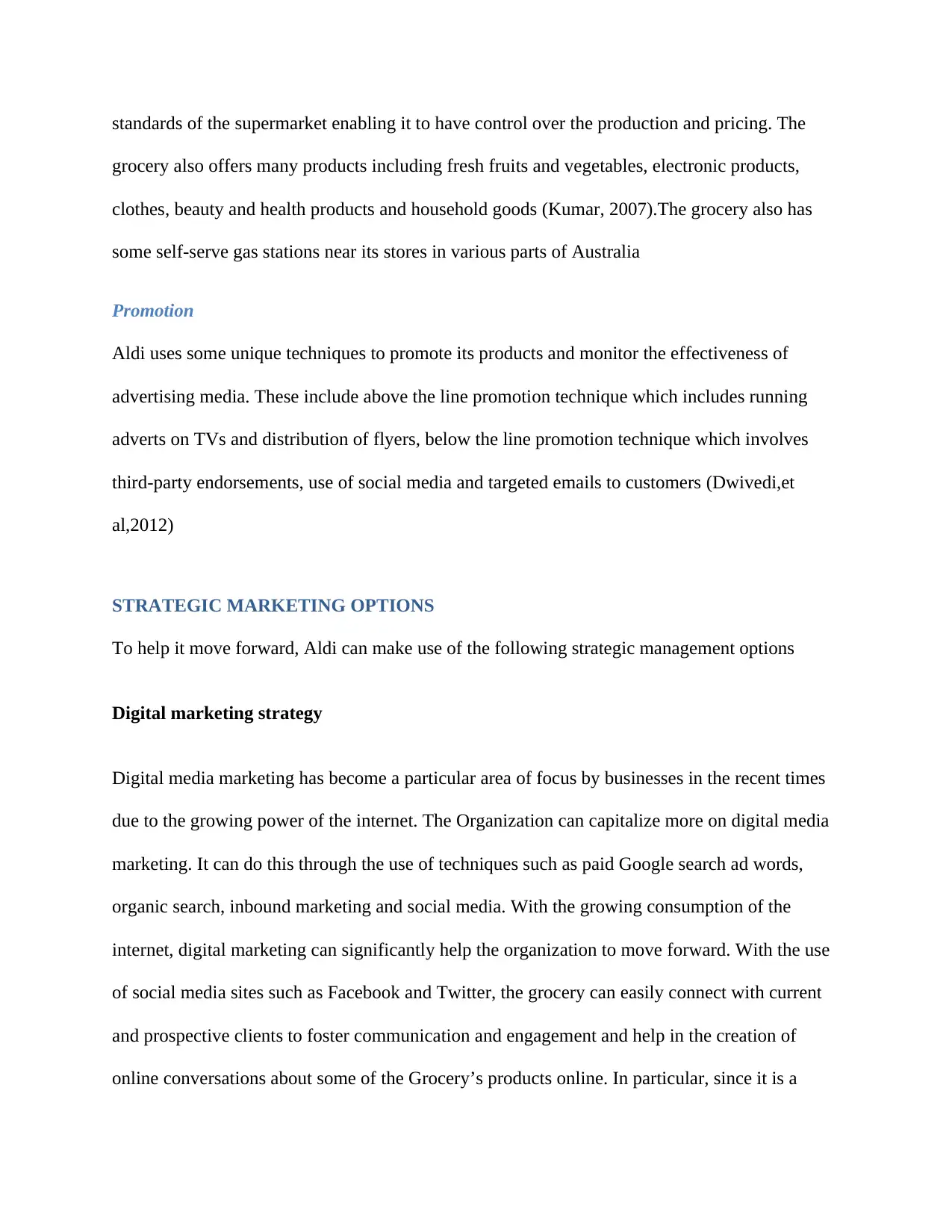
standards of the supermarket enabling it to have control over the production and pricing. The
grocery also offers many products including fresh fruits and vegetables, electronic products,
clothes, beauty and health products and household goods (Kumar, 2007).The grocery also has
some self-serve gas stations near its stores in various parts of Australia
Promotion
Aldi uses some unique techniques to promote its products and monitor the effectiveness of
advertising media. These include above the line promotion technique which includes running
adverts on TVs and distribution of flyers, below the line promotion technique which involves
third-party endorsements, use of social media and targeted emails to customers (Dwivedi,et
al,2012)
STRATEGIC MARKETING OPTIONS
To help it move forward, Aldi can make use of the following strategic management options
Digital marketing strategy
Digital media marketing has become a particular area of focus by businesses in the recent times
due to the growing power of the internet. The Organization can capitalize more on digital media
marketing. It can do this through the use of techniques such as paid Google search ad words,
organic search, inbound marketing and social media. With the growing consumption of the
internet, digital marketing can significantly help the organization to move forward. With the use
of social media sites such as Facebook and Twitter, the grocery can easily connect with current
and prospective clients to foster communication and engagement and help in the creation of
online conversations about some of the Grocery’s products online. In particular, since it is a
grocery also offers many products including fresh fruits and vegetables, electronic products,
clothes, beauty and health products and household goods (Kumar, 2007).The grocery also has
some self-serve gas stations near its stores in various parts of Australia
Promotion
Aldi uses some unique techniques to promote its products and monitor the effectiveness of
advertising media. These include above the line promotion technique which includes running
adverts on TVs and distribution of flyers, below the line promotion technique which involves
third-party endorsements, use of social media and targeted emails to customers (Dwivedi,et
al,2012)
STRATEGIC MARKETING OPTIONS
To help it move forward, Aldi can make use of the following strategic management options
Digital marketing strategy
Digital media marketing has become a particular area of focus by businesses in the recent times
due to the growing power of the internet. The Organization can capitalize more on digital media
marketing. It can do this through the use of techniques such as paid Google search ad words,
organic search, inbound marketing and social media. With the growing consumption of the
internet, digital marketing can significantly help the organization to move forward. With the use
of social media sites such as Facebook and Twitter, the grocery can easily connect with current
and prospective clients to foster communication and engagement and help in the creation of
online conversations about some of the Grocery’s products online. In particular, since it is a
Paraphrase This Document
Need a fresh take? Get an instant paraphrase of this document with our AI Paraphraser
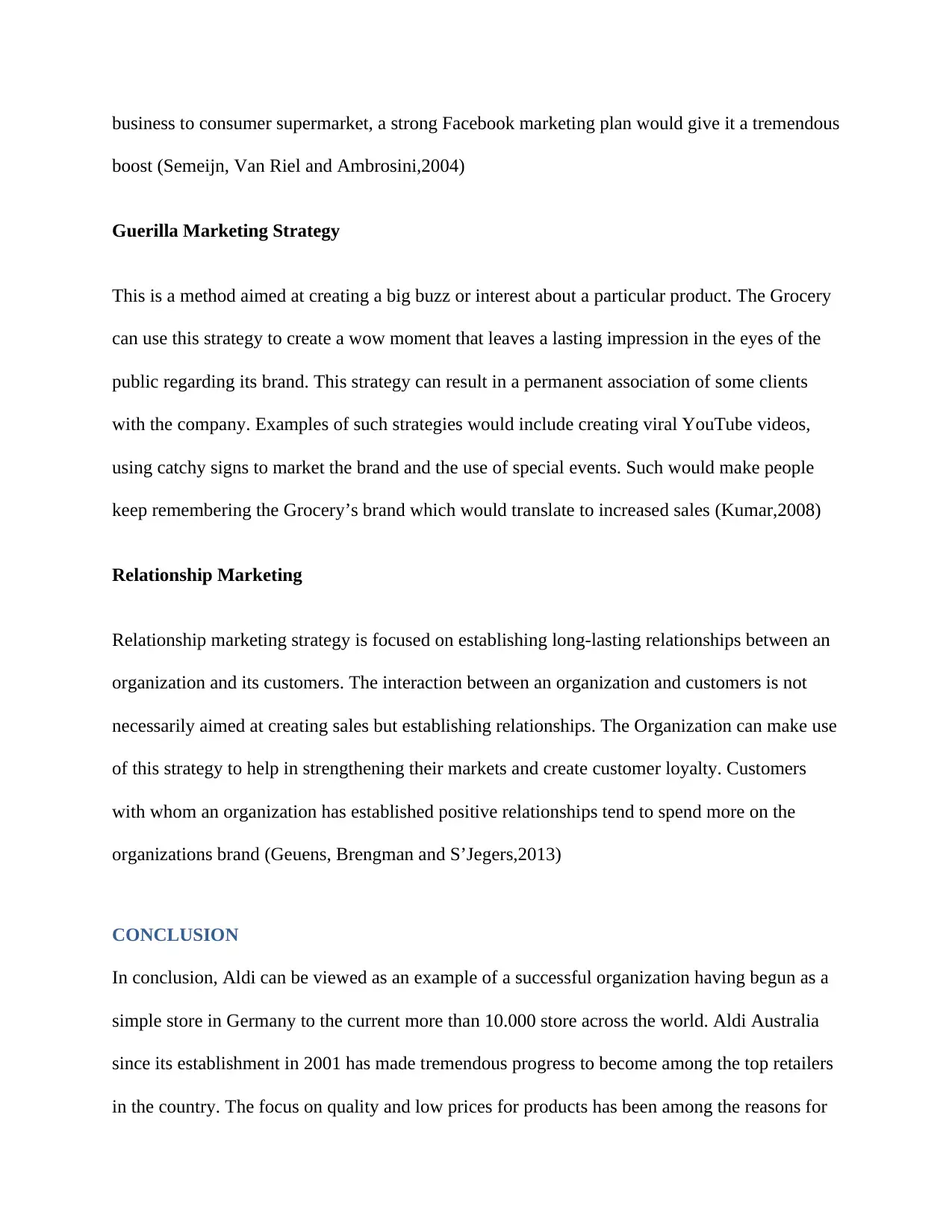
business to consumer supermarket, a strong Facebook marketing plan would give it a tremendous
boost (Semeijn, Van Riel and Ambrosini,2004)
Guerilla Marketing Strategy
This is a method aimed at creating a big buzz or interest about a particular product. The Grocery
can use this strategy to create a wow moment that leaves a lasting impression in the eyes of the
public regarding its brand. This strategy can result in a permanent association of some clients
with the company. Examples of such strategies would include creating viral YouTube videos,
using catchy signs to market the brand and the use of special events. Such would make people
keep remembering the Grocery’s brand which would translate to increased sales (Kumar,2008)
Relationship Marketing
Relationship marketing strategy is focused on establishing long-lasting relationships between an
organization and its customers. The interaction between an organization and customers is not
necessarily aimed at creating sales but establishing relationships. The Organization can make use
of this strategy to help in strengthening their markets and create customer loyalty. Customers
with whom an organization has established positive relationships tend to spend more on the
organizations brand (Geuens, Brengman and S’Jegers,2013)
CONCLUSION
In conclusion, Aldi can be viewed as an example of a successful organization having begun as a
simple store in Germany to the current more than 10.000 store across the world. Aldi Australia
since its establishment in 2001 has made tremendous progress to become among the top retailers
in the country. The focus on quality and low prices for products has been among the reasons for
boost (Semeijn, Van Riel and Ambrosini,2004)
Guerilla Marketing Strategy
This is a method aimed at creating a big buzz or interest about a particular product. The Grocery
can use this strategy to create a wow moment that leaves a lasting impression in the eyes of the
public regarding its brand. This strategy can result in a permanent association of some clients
with the company. Examples of such strategies would include creating viral YouTube videos,
using catchy signs to market the brand and the use of special events. Such would make people
keep remembering the Grocery’s brand which would translate to increased sales (Kumar,2008)
Relationship Marketing
Relationship marketing strategy is focused on establishing long-lasting relationships between an
organization and its customers. The interaction between an organization and customers is not
necessarily aimed at creating sales but establishing relationships. The Organization can make use
of this strategy to help in strengthening their markets and create customer loyalty. Customers
with whom an organization has established positive relationships tend to spend more on the
organizations brand (Geuens, Brengman and S’Jegers,2013)
CONCLUSION
In conclusion, Aldi can be viewed as an example of a successful organization having begun as a
simple store in Germany to the current more than 10.000 store across the world. Aldi Australia
since its establishment in 2001 has made tremendous progress to become among the top retailers
in the country. The focus on quality and low prices for products has been among the reasons for
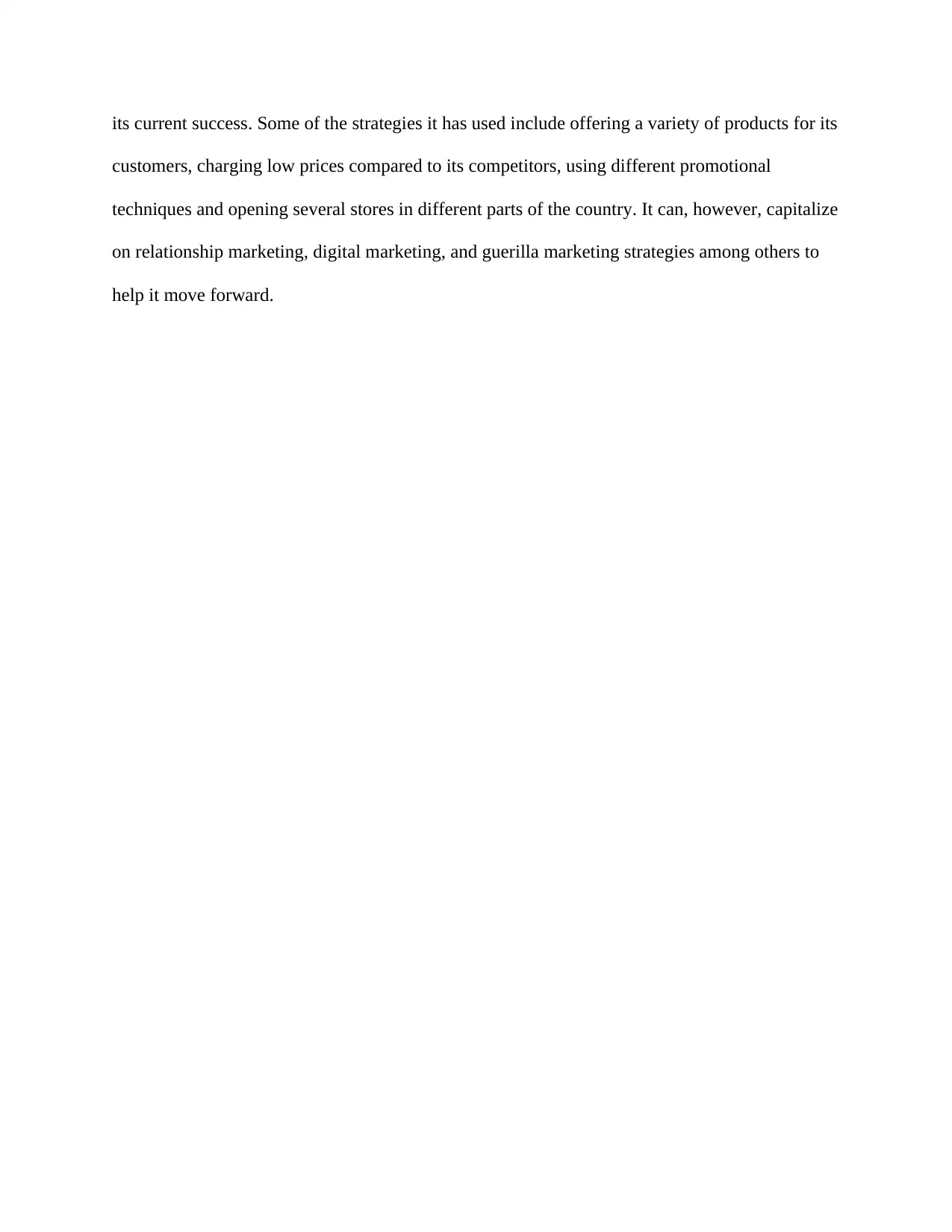
its current success. Some of the strategies it has used include offering a variety of products for its
customers, charging low prices compared to its competitors, using different promotional
techniques and opening several stores in different parts of the country. It can, however, capitalize
on relationship marketing, digital marketing, and guerilla marketing strategies among others to
help it move forward.
customers, charging low prices compared to its competitors, using different promotional
techniques and opening several stores in different parts of the country. It can, however, capitalize
on relationship marketing, digital marketing, and guerilla marketing strategies among others to
help it move forward.
⊘ This is a preview!⊘
Do you want full access?
Subscribe today to unlock all pages.

Trusted by 1+ million students worldwide
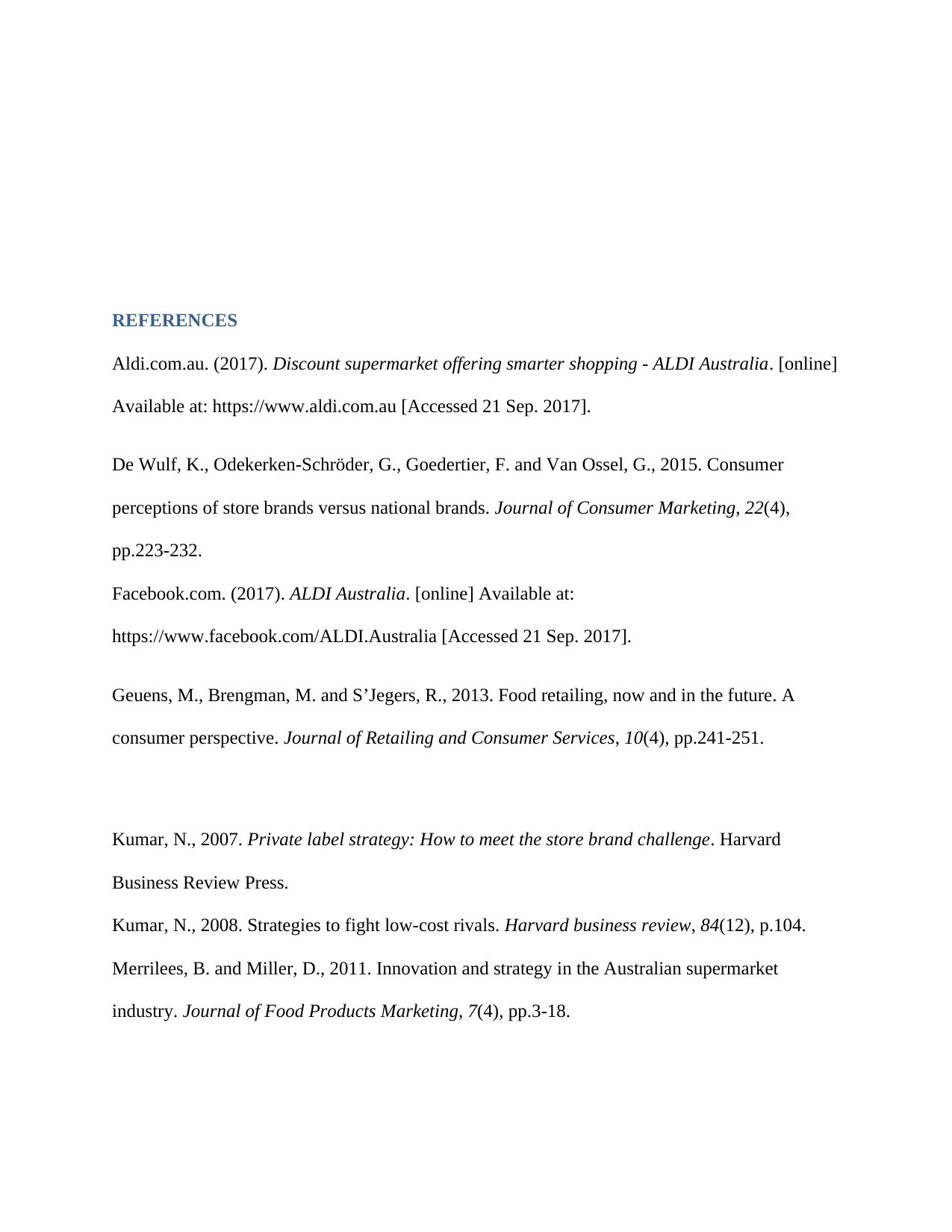
REFERENCES
Aldi.com.au. (2017). Discount supermarket offering smarter shopping - ALDI Australia. [online]
Available at: https://www.aldi.com.au [Accessed 21 Sep. 2017].
De Wulf, K., Odekerken-Schröder, G., Goedertier, F. and Van Ossel, G., 2015. Consumer
perceptions of store brands versus national brands. Journal of Consumer Marketing, 22(4),
pp.223-232.
Facebook.com. (2017). ALDI Australia. [online] Available at:
https://www.facebook.com/ALDI.Australia [Accessed 21 Sep. 2017].
Geuens, M., Brengman, M. and S’Jegers, R., 2013. Food retailing, now and in the future. A
consumer perspective. Journal of Retailing and Consumer Services, 10(4), pp.241-251.
Kumar, N., 2007. Private label strategy: How to meet the store brand challenge. Harvard
Business Review Press.
Kumar, N., 2008. Strategies to fight low-cost rivals. Harvard business review, 84(12), p.104.
Merrilees, B. and Miller, D., 2011. Innovation and strategy in the Australian supermarket
industry. Journal of Food Products Marketing, 7(4), pp.3-18.
Aldi.com.au. (2017). Discount supermarket offering smarter shopping - ALDI Australia. [online]
Available at: https://www.aldi.com.au [Accessed 21 Sep. 2017].
De Wulf, K., Odekerken-Schröder, G., Goedertier, F. and Van Ossel, G., 2015. Consumer
perceptions of store brands versus national brands. Journal of Consumer Marketing, 22(4),
pp.223-232.
Facebook.com. (2017). ALDI Australia. [online] Available at:
https://www.facebook.com/ALDI.Australia [Accessed 21 Sep. 2017].
Geuens, M., Brengman, M. and S’Jegers, R., 2013. Food retailing, now and in the future. A
consumer perspective. Journal of Retailing and Consumer Services, 10(4), pp.241-251.
Kumar, N., 2007. Private label strategy: How to meet the store brand challenge. Harvard
Business Review Press.
Kumar, N., 2008. Strategies to fight low-cost rivals. Harvard business review, 84(12), p.104.
Merrilees, B. and Miller, D., 2011. Innovation and strategy in the Australian supermarket
industry. Journal of Food Products Marketing, 7(4), pp.3-18.
Paraphrase This Document
Need a fresh take? Get an instant paraphrase of this document with our AI Paraphraser
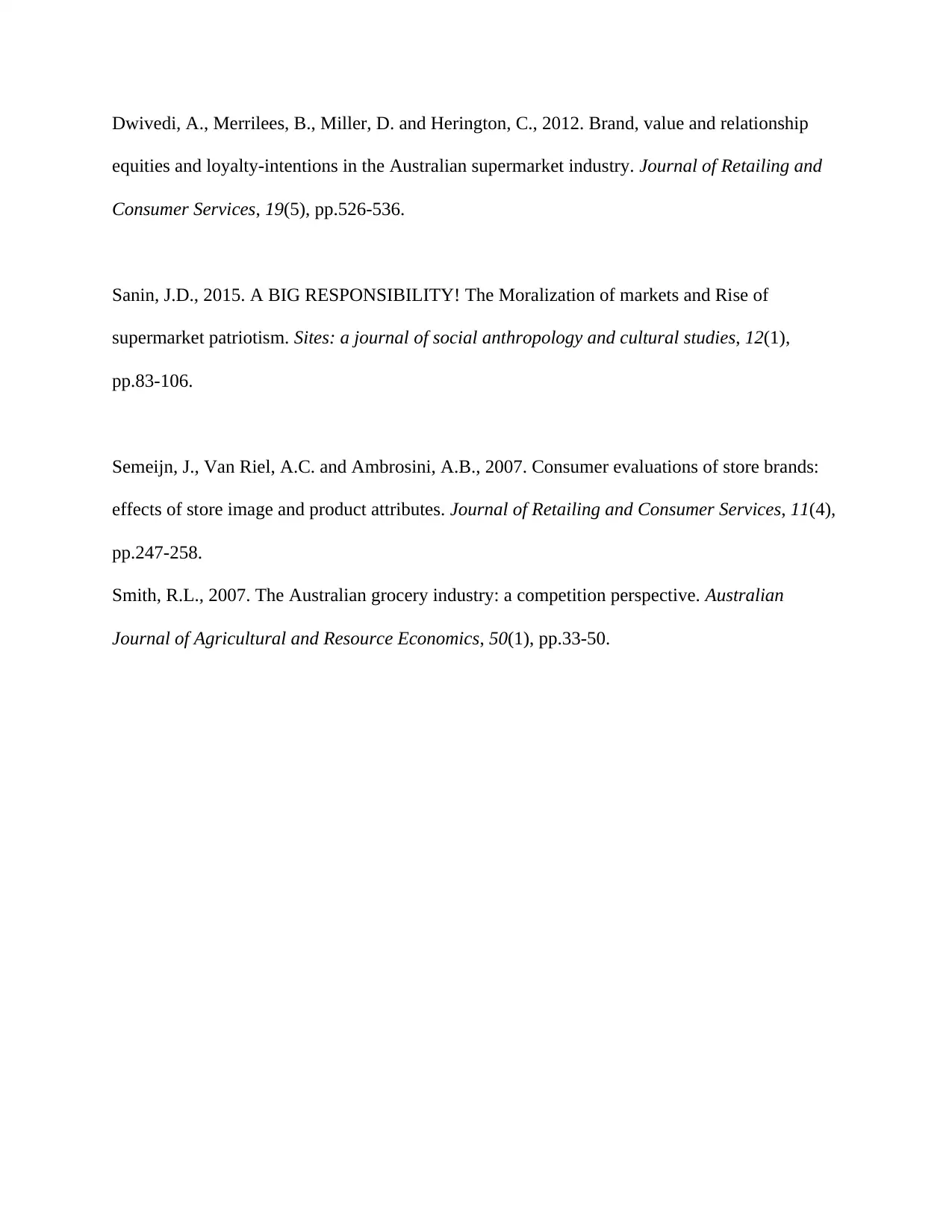
Dwivedi, A., Merrilees, B., Miller, D. and Herington, C., 2012. Brand, value and relationship
equities and loyalty-intentions in the Australian supermarket industry. Journal of Retailing and
Consumer Services, 19(5), pp.526-536.
Sanin, J.D., 2015. A BIG RESPONSIBILITY! The Moralization of markets and Rise of
supermarket patriotism. Sites: a journal of social anthropology and cultural studies, 12(1),
pp.83-106.
Semeijn, J., Van Riel, A.C. and Ambrosini, A.B., 2007. Consumer evaluations of store brands:
effects of store image and product attributes. Journal of Retailing and Consumer Services, 11(4),
pp.247-258.
Smith, R.L., 2007. The Australian grocery industry: a competition perspective. Australian
Journal of Agricultural and Resource Economics, 50(1), pp.33-50.
equities and loyalty-intentions in the Australian supermarket industry. Journal of Retailing and
Consumer Services, 19(5), pp.526-536.
Sanin, J.D., 2015. A BIG RESPONSIBILITY! The Moralization of markets and Rise of
supermarket patriotism. Sites: a journal of social anthropology and cultural studies, 12(1),
pp.83-106.
Semeijn, J., Van Riel, A.C. and Ambrosini, A.B., 2007. Consumer evaluations of store brands:
effects of store image and product attributes. Journal of Retailing and Consumer Services, 11(4),
pp.247-258.
Smith, R.L., 2007. The Australian grocery industry: a competition perspective. Australian
Journal of Agricultural and Resource Economics, 50(1), pp.33-50.
1 out of 11
Related Documents
Your All-in-One AI-Powered Toolkit for Academic Success.
+13062052269
info@desklib.com
Available 24*7 on WhatsApp / Email
![[object Object]](/_next/static/media/star-bottom.7253800d.svg)
Unlock your academic potential
Copyright © 2020–2025 A2Z Services. All Rights Reserved. Developed and managed by ZUCOL.





